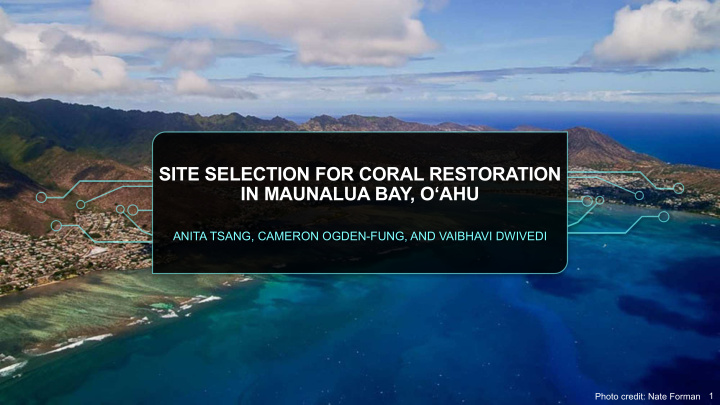



SITE SELECTION FOR CORAL RESTORATION IN MAUNALUA BAY, OʻAHU ANITA TSANG, CAMERON OGDEN-FUNG, AND VAIBHAVI DWIVEDI 1 Photo credit: Nate Forman
BACKGROUND 2 Photo credit: Matt Kieffer
RESEARCH OBJECTIVES 1) Evaluate site criteria 2) Identify ecologically suitable restoration sites for the outplanting of resilient corals 3) Prioritize sites across multiple socioeconomic objectives and scenarios 3
METHODOLOGY 4
Water Depth (3-9 m) Water Temperature (23-29 °C) Salinity (32-42 ppm) Physical Factors Turbidity (<8.8 NTU) Sedimentation (<200 g/m²/day) Benthic Type (Hard bottom) SITE Coral Cover (5-20%) CRITERIA Biological Factors Coral Health (Absent of disease) Invasive Algae (Absent) Distance from: Boat launch (<2 km) Socioeconomic Dive site (<2 km) Factors Coral nursery (<2 km) Pollutant sources (>1 km) 5
BENTHIC HABITAT MAPS 6 Source: NOAA
SALINITY AND TURBIDITY MAP Source: Salinity and turbidity data taken from the United States Geological Survey (USGS) technical reports; Bathymetry map provided by The School of Ocean and Earth Science and Technology (SOEST) 7
TEMPERATURE MAP Source: Temperature data retrieved from USGS technical report; Sewage discharge sites, dive sites, and pre-proposed restoration areas were estimated using Google Earth 8
PROPOSED RESTORATION SITES 9
SITE-SPECIFIC CRITERIA Sites Site Criteria Sub-Criteria Wailupe Paiko Channel Ku‘i Alternate1 Alternate 2 Alternate 3 Physical Water Depth (m) 3-6 3-8 3-6 0-3 3-8 3-9 3-8 Factors Water Temperature (°C) n.d. 25.25 25.13 n.d. 25.36 25.22 n.d. Salinity (ppm) n.d. 35.04 35.12 n.d. 35.04 35.02 n.d. Sedimentation n.d. n.d. n.d. n.d. n.d. n.d. n.d. (g/m²/day) Turbidity (NTU) n.d. 0.54 n.d. n.d. 1.19 n.d. 0.46 Benthic Cover Turf (50-90%) Turf (50-90%), Turf (50-90%), Turf (50-<90%), Turf (50-90%), Turf (50-90%) Turf (10-<90%) coralline algae macroalgae (10- coralline algae (10- coralline algae (50-<90%), <50%), <50%) (10-<50 %) uncolonized uncolonized Benthic Type Pavement Sand (~50%), Sand (~80%) Aggregate reef, Pavement with Pavement Sand and pavement with and pavement pavement, rubble sand channel pavement sand channel, aggregate reef Biological Coral Cover (%) <10 10-50 <10 <10 <10 <10 <10 Factors Coral Health n.d. n.d. n.d. n.d. n.d. n.d. n.d. Invasive Algae Absent Absent Absent Present Absent Absent Absent Socioeconomic Distance from boat 3.20 1.40 1.30 1.80 4.40 2.50 2.10 Factors launch (km) Distance from nearest 1.30 0.30 1.00 1.30 2.30 0.60 1.00 dive site (km) Distance from coral 2.00 0.00 1.40 1.80 3.10 1.10 1.70 nursery (km) Distance from pollutant 10 sources (km) 0.67 1.02 0.78 0.93 0.67 0.85 1.50
OBJECTIVES & SCENARIOS Weights Scenarios Educational Recreational Biophysical Cost Value Value Value Value (1) Cost value is prioritized 0.42 0.17 0.08 0.33 (2) Biophysical value is prioritized 0.33 0.17 0.08 0.42 (3) Educational value is prioritized 0.17 0.42 0.08 0.33 (4) Recreational value is prioritized 0.17 0.08 0.42 0.33 (5) All objectives are valued equally 0.25 0.25 0.25 0.25 11
RESULTS & CONCLUSION 12
MOVING FORWARD Swing weights and SMART table can be adjusted as needed Update and fill in missing data for environmental parameters “Ground truth” proposed restoration sites 13 Photo credit: Gates Coral Lab
LONG-TERM FUTURE STRATEGIES • Diving companies • Duck tour operators • SUP operators Collaborations • Public awareness • Featured videos Posters/ Education • Community workshops • Informative books Pamphlets Center • Fundraisers • Monthly talks 14
Photo credit: Tim Kopra, NASA MAHALO! 15
REFERENCES Andreyka, N., Arnott, C., Tanigawa, S., Yazzie, A. (2017). Economic Analysis Project Component: A Knowledge Domain for Assessing the Value of Maunalua Bay to Recreational Commercial Operators, 2-12. Retrieved from https://scholarspace.manoa.hawaii.edu/bitstream/10125/44555/Maunalua%20Bay%20Economics%20Knowledge%20Domain.pdf Atkinson, A. (2007). A Natural and Cultural History of Maunalua Bay and Its Watershed, 3-25. Retrieved from http://www.imuamaunalua.org/wp-content/uploads/A-Natural-Cultural-History-of- Maunalua-Bay.pdf Brown, K., Adger, W. N., Tompkins, E., Bacon, P., Shim, D., & Young, K. (2001). Trade-off analysis for marine protected area management. Ecological Economics, 37 (3), 417–434. https://doi.org/10.1016/S0921-8009(00)00293-7 Gregory, R., Failing, L., Harstone, M., Long, G., McDaniels, T., & Ohlson, D. (2012). Foundations of Structured Decision Making. In Structured Decision Making (pp. 21–46). John Wiley & Sons, Ltd. https://doi.org/10.1002/9781444398557 Huang, I. B., Keisler, J., & Linkov, I. (2011). Multi-criteria decision analysis in environmental sciences: Ten years of applications and trends. Science of The Total Environment, 409 (19), 3578– 3594. https://doi.org/10.1016/j.scitotenv.2011.06.022 Moberg, F., & Folke, C. (1999). Ecological goods and services of coral reef ecosystems. Ecological Economics , 29 (2), 215–233. https://doi.org/10.1016/S0921-8009(99)00009-9 Mustajoki, J., Hämäläinen, R. P., & Salo, A. (2005). Decision Support by Interval SMART/SWING—Incorporating Imprecision in the SMART and SWING Methods. National Academies of Sciences, Engineering, and Medicine, Division on Earth and Life Studies, Board on Life Sciences, Ocean Studies Board, & Committee on Interventions to Increase the Resilience of Coral Reefs. (2019). A Decision Framework for Interventions to Increase the Persistence and Resilience of Coral Reefs . National Academies Press. https://doi.org/10.17226/25424 Presto, M. K., Storlazzi, C. D., Logan, J. B., Reiss, T. E., & Rosenberger, K. J. (2012). Coastal Circulation and Potential Coral-larval Dispersal in Maunalua Bay, Oʻahu, Hawaii—Measurements of Waves, Currents, Temperature, and Salinity, June–September 2010. US Geological Survey Open-File Report , 2012 , 1040. Siregar, D., Arisandi, D., Usman, A., Irwan, D., & Rahim, R. (2017). Research of Simple Multi-Attribute Rating Technique for Decision Support. Journal of Physics: Conference Series , 930 , 012015. https://doi.org/10.1088/1742-6596/930/1/012015 Storlazzi, C. D., Presto, K. M., Logan, J. B., & Field, M. E. (2010). Coastal circulation and sediment dynamics in Maunalua Bay, Oahu, Hawaii. USGS Open-File Report , 1217 , 2010. Tait, R. J., E. Guinther, and R. E. Brock. (1975). Preliminary Environmental Impact Studies on the Marine Environment at Maunalua Bay. Honolulu, HI: AECOS, Inc. Wolanski, E., Martinez, J. A., & Richmond, R. H. (2009). Quantifying the impact of watershed urbanization on a coral reef: Maunalua Bay, Hawaii. Estuarine, Coastal and Shelf Science, 84 (2), 259–268. https://doi.org/10.1016/j.ecss.2009.06.029 16
Recommend
More recommend